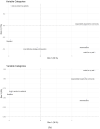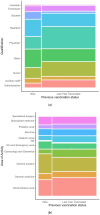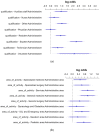COVID-19 and Influenza Vaccination Campaign in a Research and University Hospital in Milan, Italy
- PMID: 35682083
- PMCID: PMC9180437
- DOI: 10.3390/ijerph19116500
COVID-19 and Influenza Vaccination Campaign in a Research and University Hospital in Milan, Italy
Abstract
Background: Healthcare workers (HCWs) are a historical key target of influenza vaccination programs. For the 2021-2022 season, WHO considered the coadministration of a flu and a COVID-19 vaccine as acceptable and recommended it to allow for higher uptake of both vaccines. The aim of this study was to investigate demographic and occupational features of vaccinated HCWs, reasons behind flu vaccine acceptance and a possible effect of the coadministration of a COVID-19 vaccine, in order to potentially draw general conclusions on HCWs' attitude towards flu vaccination and inform further strategies for consistent improvement of vaccine acceptance.
Methods: a promotional and educational campaign, a gaming strategy, and vaccination delivery through both a large central hub and on-site ambulatories, were the implemented strategies. In the central hub, the flu/COVID-19 vaccine coadministration was offered. Statistical descriptive analysis, multiple correspondence analysis (MCA) and logistic regression models were performed.
Results: 2381 HCWs received the flu vaccine, prompting a vaccination coverage rate (VCR) of 52.0% versus 43.1% in the 2020-2021 campaign. Furthermore, 50.6% vaccinated HCWs belonged to the 18-39 years-old age group. The most expressed reasons for vaccine uptake were "Vaccination is the most effective strategy of prevention" (n = 1928, 81.0%), "As HCW it's my duty to get vaccinated to protect my patients" (n = 766, 32.2%), and the group of COVID-19-related reasons (n = 586, 24.6%). In addition, 23.3% HCWs received the flu vaccine in the current campaign but not in the previous one (newly vaccinated) and the flu/COVID-19 vaccine coadministration was more frequent in this group. A total of 51.0% HCWs were hesitant towards the coadministration, while residents and nurses showed the highest propensity to receive it.
Conclusions: in the second year of the COVID-19 pandemic, the Fondazione's influenza VCR continued to increase, with the greatest participation among HCWs aged 18-39 years. A potential propelling role of the COVID-19 vaccine coadministration was highlighted.
Keywords: COVID-19 vaccine; healthcare workers; influenza vaccine; vaccination coverage; vaccine acceptance; vaccine adherence; vaccine coadministration; vaccine compliance.
Conflict of interest statement
The authors declare no conflict of interest.
Figures






References
-
- Iuliano A.D., Roguski K.M., Chang H.H., Muscatello D.J., Palekar R., Tempia S., Cohen C., Gran J.M., Schanzer D., Cowling B.J., et al. Global Seasonal Influenza-associated Mortality Collaborator Network. Estimates of global seasonal influenza-associated respiratory mortality: A modelling study. Lancet. 2018;391:1285–1300. doi: 10.1016/S0140-6736(17)33293-2. - DOI - PMC - PubMed
-
- European Centre for Disease Prevention and Control (ECDC) Factsheet about Seasonal Influenza. [(accessed on 10 March 2022)]. Available online: https://www.ecdc.europa.eu/en/seasonal-influenza/facts/factsheet.
-
- World Health Organization (WHO) Influenza (Seasonal) [(accessed on 10 March 2022)]. Available online: https://www.who.int/news-room/fact-sheets/detail/influenza-(seasonal)
-
- Ministero della Salute—Prevenzione e Controllo dell’Influenza: Raccomandazioni per la Stagione 2021–2022. [(accessed on 10 March 2022)]; Available online: https://www.trovanorme.salute.gov.it/norme/renderNormsanPdf?anno=2021&co....
MeSH terms
Substances
LinkOut - more resources
Full Text Sources
Medical
Research Materials

